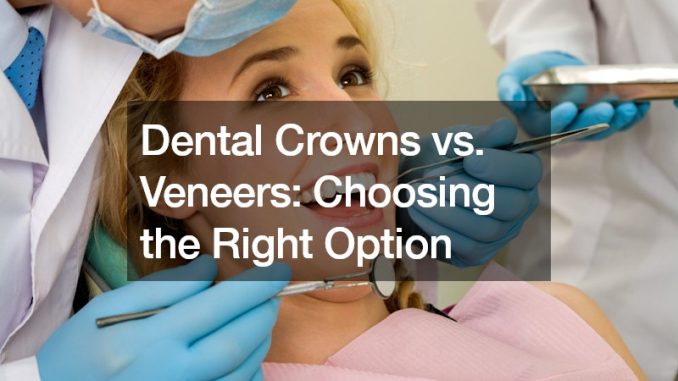

A beautiful smile can significantly boost your confidence and overall well-being. Yet, chipped, cracked, discolored, or misaligned teeth can detract from your smile’s aesthetics. Fortunately, modern dentistry offers solutions like dental crowns and veneers to address these concerns. But with both options available, choosing the right one can be confusing. This article explores the key differences between dental crowns and veneers, helping you make an informed decision for a radiant smile.
Dental Crowns: Strength and Restoration
Dental crowns, also known as caps, are tooth-shaped restorations that completely encase the visible portion of a tooth above the gum line. They offer a combination of aesthetic improvement and structural reinforcement, making them ideal for several situations:
- Severely damaged or fractured teeth: If a tooth has sustained significant damage from trauma, decay, or a large filling, a crown can provide the necessary support and prevent further deterioration.
- Root canal treatment: Following a root canal, the tooth becomes brittle and susceptible to breakage. A crown protects the weakened tooth structure.
- Large fillings: When a large cavity requires a substantial filling, the remaining tooth structure might be insufficient. A crown reinforces the tooth and prevents future breakage.
- Cosmetic enhancements: While crowns primarily serve a restorative purpose, they can also improve the appearance of misshapen, discolored, or misaligned teeth.
The Crown Procedure:
Placing a crown typically involves multiple appointments. During the initial visit, the dentist examines the tooth, removes any decay or damaged tissue, and shapes the remaining tooth structure to accommodate the crown. An impression is then taken to create a custom-made crown in a dental laboratory. In the meantime, a temporary crown is placed to protect the prepared tooth.
At the subsequent appointment, the permanent crown is carefully bonded to the prepared tooth using dental cement. Crowns are typically made from porcelain fused to metal (PFM) or zirconia. PFM crowns offer excellent durability but may have a slightly metallic appearance at the gum line. Zirconia crowns are highly esthetic, mimicking the natural tooth color, but might not be as strong for teeth subjected to heavy biting pressure.
Veneers: Enhancing the Smile’s Aesthetics
Veneers are thin shells of tooth-colored porcelain or composite resin that are bonded to the front surface of a tooth. Unlike crowns, veneers primarily address cosmetic concerns and require minimal removal of the underlying tooth structure. Veneer teeth are ideal for:
- Discolored or stained teeth: Veneers effectively mask stubborn stains or discoloration that cannot be addressed with teeth whitening treatments.
- Chipped or cracked teeth: Minor chips or cracks on the front teeth can be concealed using veneers, restoring the tooth’s natural appearance.
- Gapped teeth: Veneers can close small gaps between the front teeth, creating a more uniform smile.
Unevenly shaped or sized teeth: Veneers can be used to reshape slightly misaligned or misshapen teeth, achieving a more balanced smile.
The Veneer Procedure:
The veneer placement process usually involves two appointments. During the first visit, the dentist assesses your teeth and discusses your desired outcome. A minimal amount of enamel is then removed from the tooth surface to accommodate the veneer’s thickness. This ensures a natural and seamless appearance. Next, an impression is taken of the prepared tooth to create custom-made veneers.
On the second visit, the dentist carefully bonds the veneers to the prepared teeth using a strong dental adhesive. Veneers typically require less chair time compared to crowns and are generally considered a less invasive procedure. Porcelain veneers offer superior durability and stain resistance compared to composite veneers, but they are also more expensive.
Choosing Between Crowns and Veneers:
The choice between crowns and veneers depends on the specific condition of your teeth and your desired outcome. Here’s a breakdown to help you decide:
- Extent of tooth damage: Crowns are the preferred choice for severely damaged or structurally compromised teeth. Veneers are suitable for teeth with minor damage or cosmetic concerns.
- Location of the tooth: Crowns are more appropriate for back teeth that endure stronger biting forces. Veneers are primarily used for front teeth, where aesthetics are a priority.
- Desired outcome: If your primary concern is restoring the strength and functionality of a damaged tooth, a crown is the better option. If you seek to improve the appearance of your front teeth, veneers might be the answer.
Consultation is Key:
Consulting a qualified dentist is crucial for determining the most suitable option for your situation. They will examine your teeth, discuss your goals, and recommend the best course of treatment, whether it’s crowns, veneers, or alternative solutions.
The Final Smile:
Dental crowns and veneers offer effective solutions for restoring the health and beauty of your smile. By understanding their strengths, limitations, and suitability for different situations, you can make an informed decision in consultation with your dentist. With proper care and maintenance, either crowns or veneers can help you achieve a confident, radiant smile for years to come.
.
